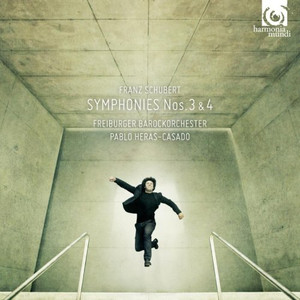
Listening is the only way to make sense of a CD that shows its conductor jumping in the air inside a 21st century concrete box, featuring 19th century music played by an orchestra specialising in baroque music.
- Classical Music 101: What Does A Conductor Do? - June 17, 2019
- Classical Music 101 | What Does Period Instrument Mean? - May 6, 2019
- CLASSICAL MUSIC 101 | What Does It Mean To Be In Tune? - April 23, 2019
 Fortunately, the mixed messages dissipate as soon as the first notes sound on a remarkable new album featuring the Symphonies Nos 3 and 4 by Franz Schubert (1797-1828). He wrote them as an 18 and 19-year-old. Joseph Haydn had been dead for less than 10 years. Beethoven was alive and flailing.
Fortunately, the mixed messages dissipate as soon as the first notes sound on a remarkable new album featuring the Symphonies Nos 3 and 4 by Franz Schubert (1797-1828). He wrote them as an 18 and 19-year-old. Joseph Haydn had been dead for less than 10 years. Beethoven was alive and flailing.
Classical in form but pushing the expressive envelope (imagine the sort of symphony your hormonal teenager might write, if she could), there is a lot to love in this music, which we don’t get to hear often enough.
Perhaps it’s because modern symphony orchestras homogenize the sound a bit too much. If you push a modern instrument as hard as a sforzando dynamic indication (it means to force the sound) might suggest, things get gaudy and crass very quickly.
But Schubert did place these markings in the music, which suddenly make sense when heard on the instruments of his time, which produce a less focused, less powerful sound, overall.
Conductor Pablo Heras-Casado, which we’ve been fortunate enough to experience with the Canadian Opera Company Orchestra, has teamed up with the Freiburger Baroque Orchestra on a new Harmonia Mundi album, with brilliant results.
Here, he can push his musicians as much as he pleases. They can be hormonal and sound excited rather than raucous. These interpretations, especially the “Tragic” Fourth Symphony, have their heart beating boldly on a sleeve. We get all of Schubert’s fine craft, presented in a way that keeps us listening on the edge of the seat.
I love what modern instruments can do. But I love more when a piece of music is brought to life in a way that does justice to what we imagine the composer’s intentions to have been.
There is no need for vibrato in the strings to make the music interesting. The woodwinds have a particularly mellow tone. The overall balance is perfect, the timpani thunderclaps riveting. Heras-Casado gives phrases gorgeously undulating shapes, so much so, they are almost caressable.
Wow.
Harmonia Mundi’s website is of the worst possible design: clever yet unhelpful. But you can start here.
John Terauds
- Classical Music 101: What Does A Conductor Do? - June 17, 2019
- Classical Music 101 | What Does Period Instrument Mean? - May 6, 2019
- CLASSICAL MUSIC 101 | What Does It Mean To Be In Tune? - April 23, 2019



